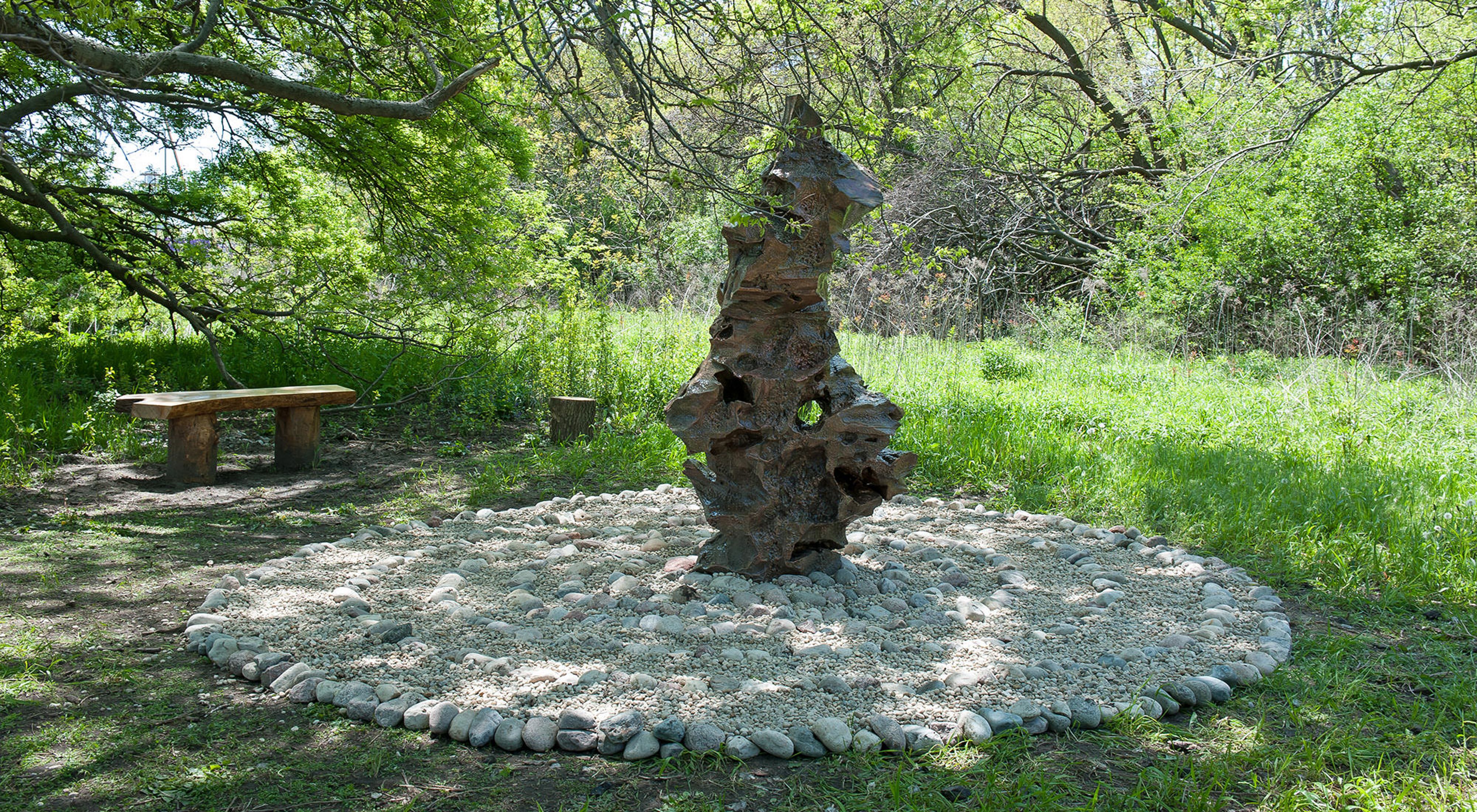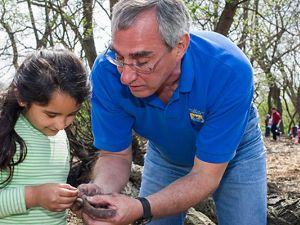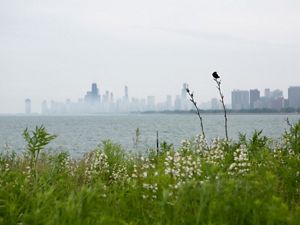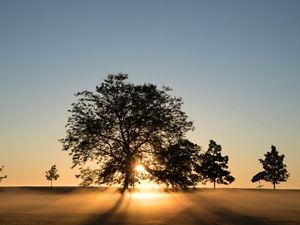Set in Stone: Where Culture, Community, and Nature Connect
Meet the partners behind this gathering space in Chicago's Burnham Wildlife Corridor
Nestled along the southern stretch of Lakeshore Drive, you’ll find walking trails, vibrant native wildflowers, towering trees, and gathering spaces filled with art from local artists. This is the Burnham Wildlife Corridor (BWC), the longest stretch of lakefront natural area within the Chicago Park District system.
The BWC is brought to life by the Roots & Routes Initiative, a group of partners who collaborate to care for the gathering spaces along the BWC and weave culture and nature together through programming. One of these spaces is Set in Stone, located at approximately 4000 S. Lake Shore Drive, just behind a parking lot off 31st St.
TNC in Illinois State Director Michelle Carr recently sat down with our partners who support this space to talk about its story, the programs we plan together, and how Set In Stone helps connect Chicago communities to nature and to each other.
Michelle: Let’s start off with introductions! I’d love to hear more about each of you, your roles, and why you and your organization became involved in the Roots & Routes Initiative.
Ben Lau: I am the Executive Director of Chinese American Museum of Chicago (CAMOC). I joined CAMOC in March of 2019 and first became involved in the partnership later that year with our Mid-Autumn Festival project. CAMOC became involved in the partnership a few years before I joined. Soo Lon Moy, our immediate Past President, has been involved intensively in the partnership right from the beginning.
Soo Lon Moy: I joined the Board of Directors of CAMOC in 2004. Recently, I stepped down after serving as President for eight years. Now I continue to serve on the Board and chair the Exhibition Committee. From the beginning, through the Coalition for a Better Chinese American Community, CAMOC was asked to represent Chinatown and to participate in the Roots and Routes Initiative's gathering spaces project. We worked with the artists Andy Bellomo and Anna Murphy for our Set in Stone site. We were honored and excited to represent the Chinese community in this meaningful collaborative project.
Ted Gross: I’m the Chicago Park District Program Specialist for the Burnham Wildlife Corridor. I've been in this position since March of 2019. The Chicago Park District has been involved with Roots and Routes since its beginning in 2014. The Chicago Park District is the landholder for the Burnham Wildlife Corridor (BWC) and has the important role of restoring and maintaining its natural areas. We also facilitate art and programming there, and work with community partners to provide stewardship to the site. I help program the space with events and activities, as well as coordinate with Roots and Routes community partners to care for this natural area, and assist with their usage of the BWC and making it more accessible to Chicagoans.
Jacob Campbell: I am an Environmental Anthropologist with the Keller Science Action Center at the Field Museum, where I lead the social science team for our Chicago region program. Along with museum colleagues, I helped establish the Roots and Routes Initiative with Chicago Park District, The Nature Conservancy and a network of community leaders, artists, and organizations. Our museum team was excited to join a collaboration that focused on the natural areas and neighborhoods nearest to our building, particularly one that worked at the intersection of human wellbeing and healthy urban nature.
Michelle: The group’s most recent collaboration was this year’s Mid-Autumn Festival, which is traditionally held in person at the Set in Stone gathering space. This year, because of COVID-19, you pivoted to an online event. Tell us about this important celebration, and how cultural events like this can help build community and connect people to nature.
Ben: The Mid-Autumn Festival, also known as Moon Festival, is a traditional festival celebrated by the Chinese. It is the second-most important holiday after the Chinese New Year, with a history dating back 3,000 years. One of the fundamental concepts the festival celebrates is gathering, such as family and friends coming together. The moon is said to be the brightest and roundest on this day, which means family reunion.
Soo Lon: This festival is similar to Thanksgiving. Families get together for a reunion dinner, sharing mooncakes and admiring the full, bright moon, while children play with their colorful lanterns and participate in many activities. There are many folklores and legends about the moon maiden, jade rabbit and the mooncakes. For the last three years, together with our partners, we celebrated Mid-Autumn Festival at Set in Stone. The programs included planting native plants, making seed balls, story-telling, lantern making, sharing a meal and mooncakes, and arts and craft activities. This year, due to the COVID-19 pandemic, a virtual Mid-Autumn Festival was held on October 3. It’s available on our website, ccamuseum.org.
Ted: The Mid-Autumn Festival has been one of Roots and Routes most attended events. Events like this are at the core of what Roots and Routes is, as they celebrate cultural heritage, community, nature and environmental stewardship. They end up building community in two ways: one is by providing a place for people of one community to celebrate their heritage, and the other is to welcome the larger Chicago community to observe, learn and participate in the cultural activities, and in environmental stewardship.
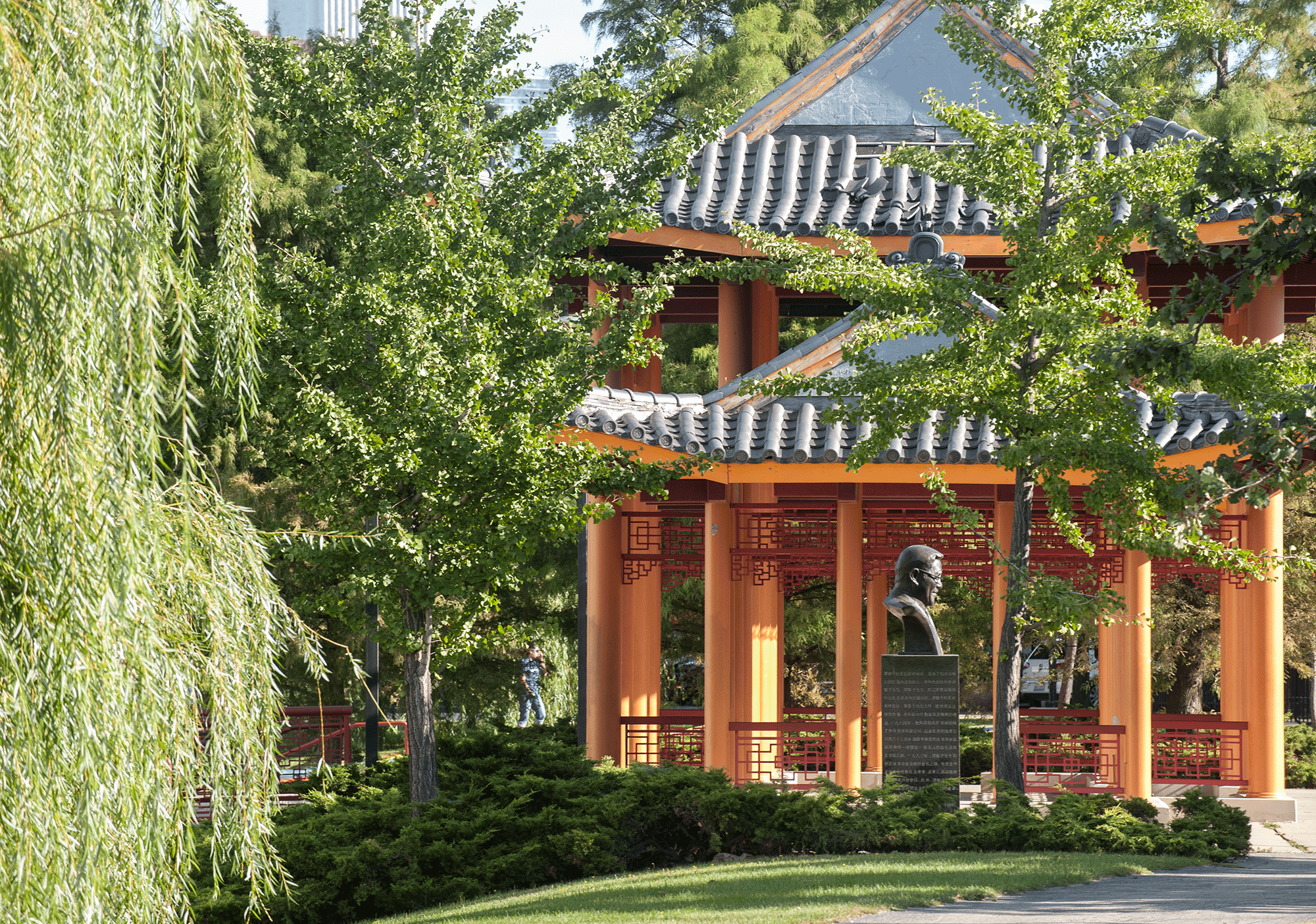
Michelle: In addition to working along the BWC and the Set In Stone gathering space, everyone here is also engaged at Ping Tom Park and its natural area. From your perspective, what is special about both of these places?
Soo Lon: In Chinese culture, nature plays an important role in the relationship to man. The twisted and eroded sculpture of the scholar's rock at Set In Stone suggests the power of nature formed beauty to be appreciated. At Ping Tom Park, the dragon gateway, pagoda pavilion, bridges, ginkgo trees and bamboo forest, and taihu stones (scholar's rocks) contrast with prairie native plants, Chicago River, granite stones and the beautiful Chicago downtown skyline. These not only reflect the Chinese traditional elements, but also the American elements to complement each other. These are perfect areas for meditation and contemplation for inner peace and mental/physical health. Many seniors, families and visitors use Ping Tom Park for tai-chi, strolls, social gatherings, enjoying the playground or to participate in the special programs provided by the City of Chicago or Chicago Park District.
Jacob: The BWC is one of Chicago’s natural gems. It provides crucial habitat for migratory birds, insects and other wildlife. You can feel immersed in nature, standing in a blooming spring meadow or walking down a forested path, even with Lake Shore Drive nearby. But I think what makes it truly special is the way in which people from historically underrepresented communities have come together to shape what the south lakefront becomes through art, cultural traditions and care for the land. The gathering spaces such as Set in Stone are a powerful example of how artists and community leaders are co-creating this public green space. Ping Tom is special in similar ways. It has emerged as both an ecological and cultural asset through strong leadership within the Chinatown community and support from a network of partners.
Michelle: How are our organizations working together to help connect people to these places?
Soo Lon: Our organizations team together to provide cultural activities and stewardship projects to bring people from the community and beyond to activate these sites, learning about and celebrating the Chinese cultural heritage as well as educating the general public about the care and stewardship of these natural areas. Already Ping Tom Memorial Park is well known to people outside the Chinatown community. Programs sponsored by various organization can help to promote our parks and gathering Spaces.
Ted: We have a steering committee made up of the Chicago Park District, the Field Museum and The Nature Conservancy, which manages our newsletter, looks for grants for funding and coordinates resources. The most valuable contributions come from our community partners. They provide direction on how they want to see the gathering spaces used, and they have put on some fantastic events like the Mid-Autumn Festival, Casa Michoacán's Dia De Los Muertos, or other events like the 2019 Night Out In The Parks event series "Nature's Notaries" with Georgina Valverde, one of the artists of the Caracol gathering space. Some of these events have even lived on during the pandemic, where Roots and Routes has coordinated to re-create them as digital events. I encourage anyone interested to go to the Events page on the Chinese American Museum of Chicago's website and explore the Mid-Autumn Festival 2020. It's a great example of what happens with Roots and Routes at the BWC that you can explore from your own home.
Quote: Ben Lau
These types of programs remind or educate the public about family reunion or community gathering, and also to be thankful for nature, which fosters the harvest and soothes our souls. It needs our care in return.
Michelle: How do these types of programs, paired with stewardship and engagement opportunities, contribute to the greater conservation of our environment?
Ben: These types of programs remind or educate the public about family reunion or community gathering, and also to be thankful for nature, which fosters the harvest and soothes our souls. It needs our care in return. Such a mindset can help people realize the importance of conservation of our environment.
Jacob: Roots and Routes programs grow from the premise that community well-being and biodiversity both benefit when cultural connections to nature are woven into the experience of urban natural areas. For this to happen, Chinese-American, Black and Latinx communities need to have access to decision-making authority, to develop multi-lingual signage and media, and to be participants in creating public green spaces that feel welcoming and serve their needs. This in turn deepens familiarity with and care for the natural environment in the city, cultivating a broad array of conservation-compatible practices.
To learn more, explore the Chinese American Museum of Chicago’s Mid-Autumn Festival 2020 web page, and stay in touch with the Roots & Routs Initiative on Facebook.
